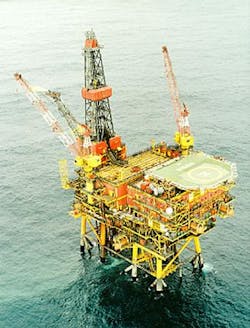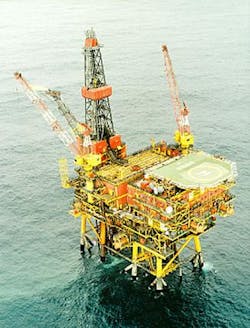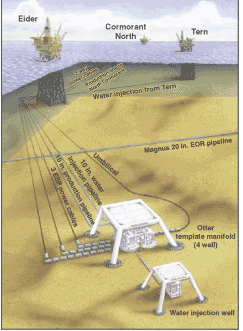Dual electric submersible pumps to drive inert Otter oil
Jeremy Beckman
Editor-Europe
North Sea operators are risking more ambitious subsea step-outs. Oil from TotalFinaElf's Otter field will be driven 23 km (including well length) to the Eider platform via downhole electric submersible pumps (ESPs). This is a significant increase on the previous distance record for subsea ESPs in the North Sea, the 14 km between Gannet E and the Gannet A platform.
However, TotalFinaElf views its scheme as a standard-bearer for future developments, rather than a gamble. Dual ESPs – a world first – are being fitted in each of Otter's three production wells to provide backup and minimize workover interventions. The project will also extend the service life of Shell's Eider platform, which otherwise faced permanent shutdown in 2004/5.
Phillips discovered Otter, formerly known as Wendy, in 1977 in UK northern North Sea block 210/15a, in 182 m of water. Petrofina acquired the undeveloped field and surrounding acreage in 1994, when it was seeking a new role as a production operator. It drilled a successful appraisal well in 1995 and launched development studies the following year, entru-sted to Offshore Design Engineering. Among the concepts screened were a stand-alone FPSO loading facility and subsea wells tied back to a third-party platform.
No natural drive
The field is a mid-Jurassic accumulation lying at a depth of 2,000 m in Brent sandstone formations. Although the crude is good quality, the reservoir lacks natural drive, with relatively little associated gas. Importing lift gas was considered initially, the problem being how to do so economically and efficiently with supplier fields all more than 20 km distant. Planning was then stalled, first by low oil prices in 1998, and later by the asset review resulting from the merger with Total and Elf. However, Otter was considered worth retaining as potential feedstock for the Sullom Voe terminal on Shetland, of which TotalFinaElf Exploration UK PLC had a 9% interest.
"There was a renewed determination to use the full technical know-how of the combined group to get this project moving," says Jacques Azibert, Northern North Sea asset manager for TotalFinaElf. "The challenge was how to make the development economic using new technologies, and also how to make use of the nearby infrastructure."
All the earlier provisional schemes were based on three producer wells and two injectors with full reservoir voidage, and this principle was retained. One new idea was to accelerate production to enhance the project's economics. TotalFinaElf now inclined toward a subsea development, although options for the host platform had narrowed, with capacity on BP's Magnus being complicated by a new scheme to enhance oil recovery through gas piped from the Foinaven field.
Alternative drive
Thinking then veered toward use of ESPs as an alternative drive mechanism to gas, powered remotely by individual electrical cables. "Total already had experience with ESPs in the Middle East, while Elf had used them off West Africa," says Jacques Azibert, Northern North Sea asset manager for TFE. "We then consulted with other operators with applications in the North Sea, such as Chevron on Alba and Texaco on the Captain wells. For them the main technical challenge was sand control. But the feedback was generally encouraging. We also had a lot of support through our partner Shell, which had subsea ESP deployment on Gannet."
Eider now came into focus as the preferred host for Otter, despite also being a field with little associated gas. This meant there would be no facilities to fall back on for gas lift if individual ESPs failed. But there was spare capacity on the platform for water injection (supplied from nearby Tern platform), electricity generation, and produced-water-handling facilities. TotalFinaElf then looked seriously at dual ESPs, the approach EnCana (UK) Ltd. and others had tried with some success onshore Canada in wells producing high quantities of sand.
"Although in that case the pumps had relatively short life spans," Azibert says, "we felt the concept was extendable to a subsea development."
Early in 2000, TotalFinaElf decided to appraise Otter's potential through a "needle" well – a relatively low-cost, slim-casing well not designed for subsequent re-use. This identifed reasonable quality, 36° API crude, with a gas-oil ratio of around 400 cf/bbl. Planning gathered pace, with front-end engineering and design, including topsides equipment modification, being comp- leted that July.
Development plan
Once an acceptable tariff had been negotiated for use of the Eider-N. Cormo-rant-Brent pipeline export system, a £145-million development plan was submitted, with UK government sanction in March 2001. In addition to Shell, the other partners in the project are ExxonMobil and Agip.
Otter is being developed through three horizontal producer wells, with open-hole gravel packs designed and installed by Hallibur-ton. This is a technique also employed routinely on Alba and Captain.
"There is a fairly small risk of sand production on Otter," says TotalFinaElf UK Northern North Sea Development Manager Kevin Boyne, "but we don't want to take any risks. We feel that this is the most robust way to ensure that sand doesn't get into the pumps. It is a relatively shallow-lying reservoir, so there is some doubt about sand distribution. We know some of the sands in the lower Ness formation are less consolidated."
Schlumberger is managing the directional drilling, with the drains being piloted using some sophisticated geosteering techniques such as the use of chemo-stratigraphy (provided by Sperry-Sun) of the drill cuttings to identify on site which of the Brent sequence layers has been drilled.
The three producer wells and the new injector well are being drilled through a 145-ton subsea template manifold manufactured by Grenland Offshore and installed by the Maxita vessel using FMC Kongsberg's hinge-over installation technique. Manifold equipment includes a multi-phase meter from Roxar. The wells will be controlled from Eider via a Duco electro-hydraulic/chemical injection umbilical and an FMC-Kongsberg multiplexed subsea control system. The second water injector has already been drilled, being a re-completion of the 1995 appraisal well. The injectors will allow reservoir pressure to be sustained throughout most of the field's life close to production start-up levels.
The two 21-km, 10-in. pipelines have been laid by the Technip-Coflexip reel vessel Apache, and the umbilical, three 21-km ESP power cables, by the sub contracted Normand Pioneer. One pipe-line exports Otter's multi-phase flow to Eider. The other supplies injection water from the other direction.The latter will also allow round-trip pigging from Eider.
On arrival at the platform, produced water will be separated out, with oil and gas commingled with Eider's own production for onward transport to Shell's North Cormorant platform through an existing 12-in., 13-km oil export pipeline. This will now operate multi-phase. Some of Otter's gas will be retained for power generation on Eider, with the remainder reinjected with the export oil into the pipeline to minimize flaring on the Eider platform. Following further separation on North Cormorant, the oil will be piped 170 km to Sullom Voe through the Brent export system with gas directed 450 km to the St. Fergus terminal via the Far-north Liquids and Associated Gas Gathering system.
Slug suppression
The new gas content explains the need to install on North Cormorant a slug suppression device (S3D) manufactured by Drilquip and developed by Shell Global Solutions in The Netherlands.
"Our experts witnessed it in action on their test loop in Holland," says Boyne. "On Eider, an intelligent choke system has been installed with a built-in algorithm that senses the presence of a slug and compensates by opening or closing the choke."
Baker Hughes Centrilift as the primary contractor for the supply of the three dual-ESP completion systems, with associated flow control and monitoring systems designed and manufactured by Phoenix. Wet mateable electrical connectors and penetration systems were designed and manufactured by Tronic, and topsides variable frequency drive modules designed and manufac- tured by Robicon and Vertec.
In addition to giving a very efficient lift system, the dual-ESP configuration mitigates the risk of unplanned maintenance by providing backup should the primary system fail prior to a scheduled workover. This arrangement also allows the wells to continue producing with high levels of water cut, thereby boosting recovery. Pump speed, flowrate, and pressure and temperature both upstream and downstream of the pumps will be monitored, using a downhole monitoring facility supplying information via the electric cables to Eider, North Cormorant, and a monitoring station at Baker Hughes Centrilift office in Dyce, Scotland.
A specially designed hydraulically actuated subsea switch system (with ROV backup) located on each christmas tree can be used for switching power to the backup ESP.
"During operation, normal pressure at the wellhead will be 60-70 bar," says Boyne, "but we can adjust this if needed using the pumps speeds and chokes if we detect an unstable flow regime. The pumps have been sized so that even running at full speed, in case of inadvertent shut-in, they cannot exceed the pipeline's maximum allowable operating pressure."
All the system's main components have undergone thorough testing this year. Centrilift has performed a range of integration tests, including an electrical string test carried out at Tulsa and a test completion installation carried out at the DTL well testing facilities in Aberdeen. The string test conducted at Centrilift facilities at Tulsa simulated the performance of the 23-km control cables with Otter's variable frequency drive system over a range of operating conditions including start-up.
Main objectives during the program at DTL were:
- To confirm the equipment needed for the rig floor set-up and also the dual ESP's assembly procedure
- To confirm the correct operation of the variable-speed drive and ESP downhole monitoring system and completion assembly across a 40-70 Hz frequency range
- To familiarize field service and operator personnel with the equipment and procedures.
"The test programs for the pumps were largely successful," says Boyne, "in that they identified some problems leading to modifications to both the downhole flow meters and the variable frequency drive systems on Eider."
Integration tests were also performed in other locations on the control systems and the wellhead-christmas tree template interfaces (FMC Kongsberg).
"The trees were designed for diverless installation," Boyne said. "In contrast with the vertical Gannet subsea tree design, we went for horizontal christmas trees, as these make the task of ESP retrieval easier during workovers. This is because the completions can be pulled through the trees rather than to have to remove the trees to carry out workovers. We're targeting a deployment life for the dual-ESP completion systems of two years between workovers. That may prove conservative, as some single pump applications have achieved a working life of three years."
Thermal insulation
To minimize chemical requirements, the production line features a 49-mm layer of polypropylene thermal insulation, supplied by Tenaris, to achieve a U-factor of 3W/m2°K. This level of insulation, which has been achieved by the combination of insulation and burial (the pipe is buried to a depth of 1 m), is required to keep the oil temperature as high as possible and to reduce viscosity. Nevertheless, the umbilical, in addition to control functions, has provision to inject as required the following:
- Methanol and kinetic hydrate inhibitor to prevent hydrate formation during shutdowns and start-ups
- Wax inhibitor to limit waxing tendencies during periods at low production rates and for shutdowns and start ups when temperatures may drop below 26° C
- Scale/corrosion inhibitor to counteract possible scaling and corrosion caused by the mixture of formation and injection water.
There is also the possibility to perform intermittent bullhead squeezes through the water injection system. The water injection pipe was coated using an anti-corrosive, three-layer polypropylene from Socotherm in Italy, under sub-contract to Tenaris.
"During the first few months of production," Boyne says, "we intend to simultaneously drill and produce and will commission and test each of the pump systems and use them to boost production as the wells become available. When all three wells become available, it should be possible to maintain a plateau of 30,000 b/d, with some or all of the wells producing initially under natural flow to conserve pump life. Water will then be injected at a rate up to 44,000 b/d. We will try to produce the field as quickly as possible and to maintain production until we reach 90% water cut, in around 2009-10."
TotalFinaElf is now looking at replicating this plan in other offshore areas, including deepwater projects. Potential applications could include fields in the Far East and Middle East. Boyne also points out that Petrobras is using ESPs for tiebacks of deepwater fields to host platforms in shallow waters.


